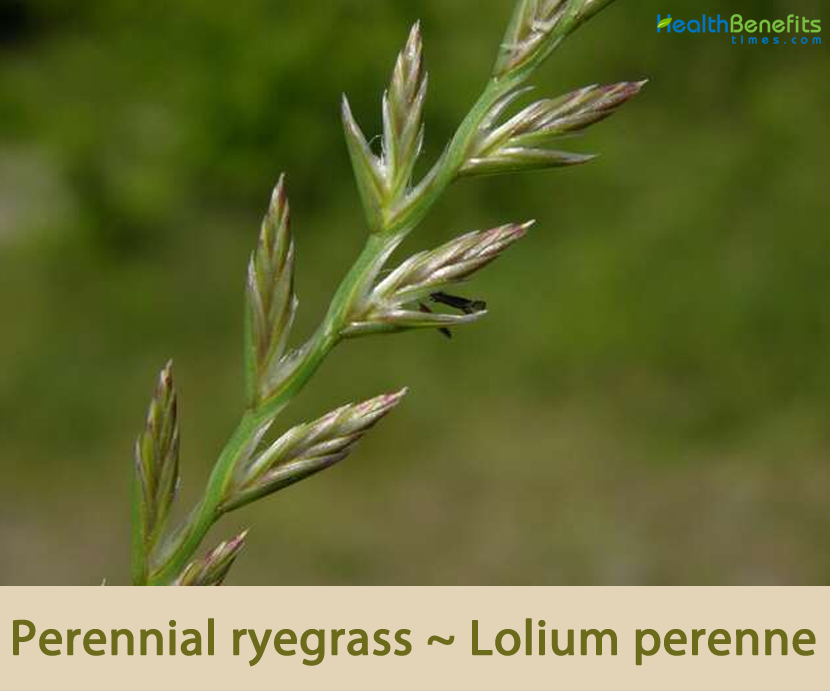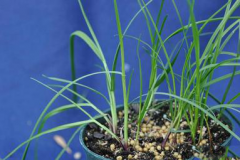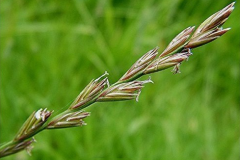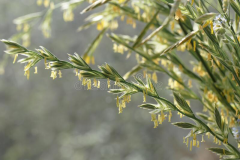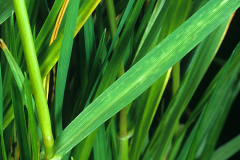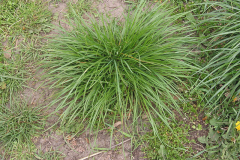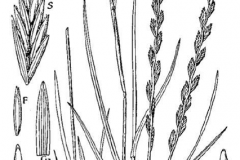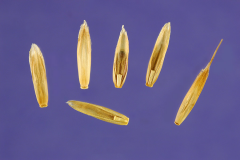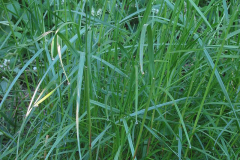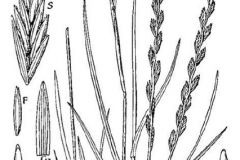| Perennial ryegrass Quick Facts | |
|---|---|
| Name: | Perennial ryegrass |
| Scientific Name: | Lolium perenne |
| Origin | Northern Africa (i.e. Algeria, Egypt, Libya, Morocco and Tunisia), the Azores, the Madeira Islands, the Canary Islands, Europe, western Asia, southern Russia, Afghanistan and the Indian sub-continent |
| Colors | Light tan (Seed) |
| Shapes | Grains are 3-5.5 mm. long and 0.7 to 1.5 mm wide, narrowly oblongoid in shape, narrowly grooved along one side (Seed) |
| Health benefits | Support for cancer, diarrhea, hemorrhages and malaria. |
| Name | Perennial ryegrass |
|---|---|
| Scientific Name | Lolium perenne |
| Native | Northern Africa (i.e. Algeria, Egypt, Libya, Morocco and Tunisia), the Azores, the Madeira Islands, the Canary Islands, Europe, western Asia, southern Russia, Afghanistan and the Indian sub-continent (i.e. Pakistan and north-western India) |
| Common Names | English ryegrass, perennial rye grass, perennial rye-grass, perennial ryegrass, ryegrass, rye grass, Italian ryegrass, Darnel, Lyme Grass, Terrell Grass, ray grass |
| Name in Other Languages | Afrikaans: Meerjarige raaigras Albanian: Egjri shumëvjeçar, egjër Arabic: Gazun (جزون،) hashish alfurs (hashysh alfars) (حشيش الفرس (حَشيش الفَرس), samah (sammh) (صامه (صَامّه), zawan mueamar (زوان معمر) Basque: llollo belarra, llollo-belarra, llollobelar ingeles, lolloa, Ingeles llollobelar Belarusian: Zycik mnohahadovy (жыцік многагадовы) Bulgarian: Angliĭski raĭgras (английски райграс), pasishten raĭgras (пасищен райграс) Catalan: Margay, margall, margall perenne, margall trepitjat, raigrà, raigràs angles Chinese: Duo nian hei mai cao (多年黑麦草 ), Hei mai cao (黑麦草) Croatian: Višegodišnji ljulj Czech: Jílek anglický, Jílek ozimý, Jílek vytrvalý Danish: Almindelig rajgræs Dutch: Engels raaigras English: English ryegrass, Perennial ryegrass, Eavers, darnel, Lyme rye grass, strand-wheat, Terrell’s grass Estonian: Inglise raihein, Karjamaa-raihein Finnish: Englanninraiheinä French: Ivraie vivace, Ray-grass anglais, ray-grass, ray-grass commun Galician: Ballico German: Ausdauerndes Weidelgras, Deutsches Weidelgras , Englisches Raygras, ausdauernder Lolch, Dauerlolch, Dauerweidelgras, englisches Raygras, Raigras Greek: Íra polyetís ( Ήρα πολυετής ), Lolio to polietes (Λόλιο το πολυετές ), polyetís íra (πολυετής ήρα) Hebrew: Zun rav-shenati, זוּן רַב-שְׁנָתִי Hungarian: Angolperje Icelandic: Vallarrýgresi Italian: Loglierella, Loietto inglese, Loglio comune, Loglio inglese, Loglio perenne, loiessa Japanese: Pereniaru raigurasu (ペレニアルライグラス), Hoso mugi (ホソムギ ), bereniaru-raigurasu Kabyle: Aṛaṭiw izirdi Kashubian: Wëtrzëmałi pòszczesnik Korean: Homilpul Latvian: Daudzgadīgā airene Lithuanian: Daugiametė svidrė Macedonian: Obična pijanka (обична пијанка) Nepali: Rā’ī ghām̐sa (राई घाँस) Norwegian: Raigras, engels Raaigras Occitan: Margalh Persian: چچم پایدار Polish: Rajgras angielski, Życica trawała Portuguese: Azevém-perene, Azevém-vivaz, Gazão, Lólio-perenne, Ryegrass da Inglaterra, alcácer-de-muro, aveia-de-muro, azevém, erva-de-semente, gazão, joio-silvestre, joio-vivaz, raigrás, reigrasse-dos-ingleses, reigresse Romanian: Raigras englezesc Russian: Plevel mnogoletnij (Плевел многолетний), angliyskiy raygras (английский райграс) Serbian: Engleska trava (енглеска трава), utrinac (утринац), utrinac ljulj (утринац љуљ), obični ljulj (обични љуљ) Slovakian: Mätonoh trváci Slovenian: Angleška ljuljka, trpežna ljuljka South Africa: Meerjarige raaisgra Spanish: Ballico perenne, Césped inglés, Raigrás perenne, Raygras, Ray-grass inglés, Valluco perenne, ballico, hierba triguera, raigras ingles, raigrás, vallico, zacate ray, zacate ballico perenne Swedish: Engelskt rajgräs, engelski rajgras Turkish: Çok yıllık çim, İngiliz çimi Ukrainian: Pazhytnytsya bahatorichna (пажитниця багаторічна), Rayhras pasovyshchnyy (Райграс пасовищний) Upper Sorbian: Hładka motawa Welsh: Rhygwellt lluosflwydd, Rhygwellt parhaol |
| Plant Growth Habit | Low-growing, tufted, hairless grass, with a bunching (or tillering) growth habit |
| Growing Climates | Old fields, roadsides, railroads, waste places, shrub land, riparian habitats, freshwater wetlands, coastal beaches, grassland, pastures, meadows and disturbed places, heath, awns, vacant lots, fallow fields, open waste areas |
| Soil | Grows best on rather heavy, rich, moist soils, but also does well on well-manured lighter soils with sufficient moisture. It dislikes shade and requires a well-drained soil |
| Plant Size | 30 to 100 cm tall |
| Root | Fibrous root system, with thick main roots and thinner lateral branches. Roots are usually arbuscular mycorrhizal |
| Leaf | Leaves of perennial ryegrass are folded lengthwise in the bud (in contrast to those of annual ryegrass, which are rolled). Leaf blades are 0.08 to 0.25 inches wide (2 to 6 mm) and 2 to 6 inches long (5 to 15 cm). They are sharply taper-pointed and keeled. Blades are bright green. They are prominently ridged on the upper surface. |
| Flowering season | May-July |
| Flower | Each fertile culm terminates in a flowering spike about 4-10 inches long. This spike consists of several sessile spikelets that alternate along two sides of the rachis (central stalk of the spike). The rachis is slightly indented where each spikelet occurs, providing it with a curvilinear zigzag appearance. Each non-terminal spikelet is 8-16 mm. in length, consisting of a single outer glume at its base and 4-10 lemmas that are arranged in 2 overlapping ranks. The lemmas are 4-7 mm. in length, oblong in shape, convex along their outer surfaces, longitudinally veined, and hairless. The floret of each fertile lemma consists of an ovary, a pair of feathery stigmata, and 3 stamens. The outer glume is longer than individual lemmas, but shorter than the spikelet. Aside from its greater length, the glume is similar in appearance to the lemmas |
| Fruit Shape & Size | Grains are 3-5.5 mm. long and 0.7 to 1.5 mm wide, narrowly oblongoid in shape, narrowly grooved along one side |
| Fruit Color | Light Tan |
| Propagation | By seed |
| Traditional uses and benefits |
|
| Culinary Uses |
|
Plant Description
Perennial ryegrass is low-growing, tufted, hairless grass, with a bunching (or tillering) growth habit. The plant can grow about 30 to 100 cm tall from short rhizomes and tillers. The plants lack stolon or rhizomes. The plant is found growing in old fields, roadsides, railroads, waste places, shrub land, riparian habitats, freshwater wetlands, coastal beaches, grassland, pastures, meadows and disturbed places, heath, awns, vacant lots, fallow fields, open waste areas. It grows best on rather heavy, rich, moist soils, but also does well on well-manure lighter soils with sufficient moisture. It dislikes shade and requires a well-drained soil. The shallow root system is highly branched and produces adventitious roots from the basal nodes of tillers.
Stem
Flowering stems (culms) are comprised of nodes and internodes, each node bearing a leaf. Culms are 12 to 40 inches in height (30 to100 cm) depending on variety, moisture, and site conditions. The uppermost culm segment is called the peduncle, the structure that supports the flowering parts. The stem base commonly is reddish.
Leaves
Leaves of perennial ryegrass are folded lengthwise in the bud (in contrast to those of annual ryegrass, which are rolled). Leaf blades are 0.08 to 0.25 inches wide (2 to 6 mm) and 2 to 6 inches long (5 to 15 cm). They are sharply taper-pointed and keeled. Blades are bright green. They are prominently ridged on the upper surface. Lower surfaces are dark green, smooth, glossy, and hairless. Leaf margins are slightly rough to the touch. Blades increase in size from the first to the seventh leaf on a tiller, although tillers rarely have more than three live leaves at one time. Leaf sheaths usually are not keeled. They are compressed but some-times almost cylindrical. Sheaths are hairless, pale green and reddish at the base. They may be closed or split.
Flower
Each fertile culm terminates in a flowering spike about 4-10 inches long. This spike consists of several sessile spikelets that alternate along two sides of the rachis (central stalk of the spike). The rachis is slightly indented where each spikelet occurs, providing it with a curvilinear zigzag appearance. Each non-terminal spikelet is 8-16 mm. in length, consisting of a single outer glume at its base and 4-10 lemmas that are arranged in 2 overlapping ranks. The lemmas are 4-7 mm. in length, oblong in shape, convex along their outer surfaces, longitudinally veined, and hairless. The floret of each fertile lemma consists of an ovary, a pair of feathery stigmata, and 3 stamens. The outer glume is longer than individual lemmas, but shorter than the spikelet. Aside from its greater length, the glume is similar in appearance to the lemmas. Terminal spikelets are the same as non-terminal spikelets, except they have 2 glumes; these glumes are similar to the outer glumes of the non-terminal spikelets. As the spikelets mature, they change in color from light green to light tan. The blooming period typically occurs during early summer, although this may be delayed by disturbance.
Fruit
The florets are cross-pollinated by the wind. Afterwards, the florets of fertile lemmas are replaced by grains. At maturity, these grains are 3-5.5 mm. long and 0.7 to 1.5 mm wide, narrowly oblongoid in shape, narrowly grooved along one side, and light tan. Disarticulation of the spikelets is above the glumes. There are approximately 247,000 seeds per pound.
Few Facts
- The plant has the potential to be used as a source of biomass.
- Yields of up to 25 tons per hectare have been reported from Europe.
- In the absence of definitive yield information an average yield of 17.5 tons of dry matter per hectare per year and an energy content of 17.5 GJ per metric ton are assumed.
- There are approximately 230,000 seeds per pound.
- Perennial ryegrass is a valuable forage and soil stabilization plant.
- This species is the predominant forage grass in Europe, and has been used in the United States for forage and lawns.
Prevention and Control
Due to the variable regulations around (de)registration of pesticides, your national list of registered pesticides or relevant authority should be consulted to determine which products are legally allowed for use in your country when considering chemical control. Pesticides should always be used in a lawful manner, consistent with the product’s label.
Physical/Mechanical Control
Perennial ryegrass belongs to a group of perennial grasses that are very difficult to control with flaming. Rask et al. (2011) explored the use of flame weeding for control of a well-established dense stand of L. perenne ‘Maurice’ in Denmark. They showed that full control can be achieved with flaming, but it depends on the number of treatments as well as the dose of propane. At mean doses above 80 kg propane ha-1 with treatments carried out every second week for a year all weeds were completely killed and no regrowth was seen in the following two weeks.
On a small scale, such as in a garden, perennial ryegrass can be controlled by pulling (if the ground is soft) or by digging. On a larger scale, ploughing by turning the sod or rotary hoeing is often the standard method of destroying a perennial ryegrass crop, occasionally with the purpose of renewing the pasture with newer or more appropriate cultivars of the same species.
Biological Control
Perennial ryegrass is ideally suited for biological control as there are a large number of insect pests and diseases that can damage or even kill the grass. However, being an extremely valuable and desirable pasture and turf species, biological control is unlikely to be used.
Chemical Control
Treatment of isolated individual plants and of very large areas of perennial ryegrass with glyphosate has been a widely established agricultural practice for many years now. Initial problems with temporary spring-time resistance to the herbicide were overcome with the addition of appropriate surfactants to the herbicide.
DiTomaso et al. suggest the following herbicides for control of Perennial ryegrass in the western USA: aminocyclopyrachlor and chlorsulfuron, clethodim, fluazifop, hexazinone, imazapic, imazapyr, sethoxydim, sulfometuron, as well as glyphosate. Some of these are selective, killing grasses and not broad-leaf plants; others will kill most plants.
Control by Utilization
Overgrazing of Perennial ryegrass, especially when it is under stress, such as in a dry summer will lead to death of many of the plants and possibly their replacement by other, often weedy grass and herb species.
References:
https://en.wikipedia.org/wiki/Lolium_perenne
https://accs.uaa.alaska.edu/wp-content/uploads/Lolium_perenne_BIO_LOPE.pdf
https://www.flowersofindia.net/catalog/slides/Perennial%20Ryegrass.html
http://biology.burke.washington.edu/herbarium/imagecollection/taxon.php?Taxon=Lolium%20perenne
https://indiabiodiversity.org/species/show/243320
https://gd.eppo.int/taxon/LOLPE
https://www.itis.gov/servlet/SingleRpt/SingleRpt?search_topic=TSN&search_value=40893#null
https://npgsweb.ars-grin.gov/gringlobal/taxon/taxonomydetail?id=22494
https://pfaf.org/user/Plant.aspx?LatinName=Lolium+perenne
https://www.cabi.org/isc/datasheet/31166
http://soilcropandmore.info/crops/Grasses/Perennial_ryegrass/fs_lope.pdf
http://legacy.tropicos.org/Name/25509743
https://apg.pir.sa.gov.au/gringlobal/taxonomydetail.aspx?id=22494
http://www.illinoiswildflowers.info/grasses/plants/english_ryegrass.htm
https://hort.purdue.edu/newcrop/duke_energy/Lolium_perenne.html
https://plants.usda.gov/home/plantProfile?symbol=LOPE


